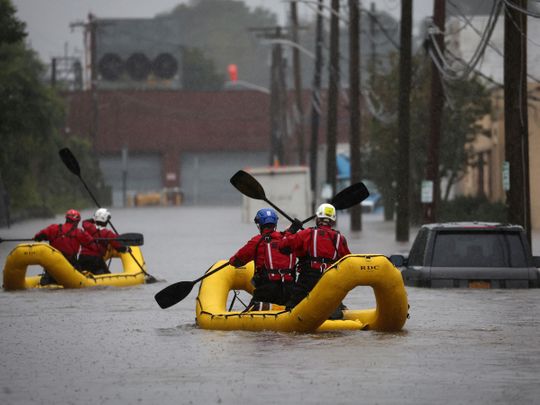
When we think of the catastrophes produced by climate change, most of us typically think of supercharged hurricanes, massive wildfires and punishing heatwaves.
But climate change can turn even a simple rainstorm into a shocking disaster.
Much of the New York metropolitan area was treading water on Friday, after hours of torrential rain that capped an already wet week. Roughly half the subway lines in one of the world’s busiest metro systems were suspended or delayed. Streets and highways around the city were flooded. The city’s airports, key national hubs, faced massive delays. People had to be rescued from flooded basement apartments.
Hottest months ever
And the rain was expected to keep coming down all day and through the night. Four to six inches had already fallen as of midday, with an estimated four more to come. That would amount to roughly two typical months’ worth of rain for the city in just 48 hours. New York Governor Kathy Hochul declared a state of emergency. Parts of New Jersey, Connecticut and Pennsylvania were also swamped.
Believe it or not, this wasn’t the result of some major tropical storm like Hurricane Sandy. In some ways, it was just a routine early-fall low-pressure system. But as we saw in Vermont and New York flooding this summer, in a warmer climate, these rainstorms can produce a whole lot more water than you’d expect. That’s because hotter air holds more moisture.
And both the air and water are as hot as they’ve been in human history. July was the planet’s hottest month on record, August was the hottest August ever, and this September is on track to be the hottest September ever. The weather system hammering New York on Friday was slowly trawling the Atlantic, sucking up ocean water — also the hottest on record — and dumping it in buckets on the land.
As we have seen in storm after storm over the years, New York’s infrastructure simply isn’t built to handle flooding. Commuters have far too many memories of subway stations turning into filthy water parks in a flash. Some New York City Council members criticised the city’s slow reaction to the storm, which suggested the downpour had come as a surprise. In city officials’ defence, the weather forecast merely called for a lot of rain.
But climate change gives a whole new meaning to the words “a lot of rain.” It’s long past time for political leaders and citizens alike to prepare differently for such forecasts. Meanwhile, some of the billions President Joe Biden and Congress allocated to infrastructure last year must be spent on waterproofing New York and other cities much more thoroughly. From hurricanes to routine fall storms, it is far too easy to bring one of the greatest cities in the world to a wet, grinding halt.
— Bloomberg
Mark Gongloff is a Bloomberg Opinion editor and columnist covering climate change.










